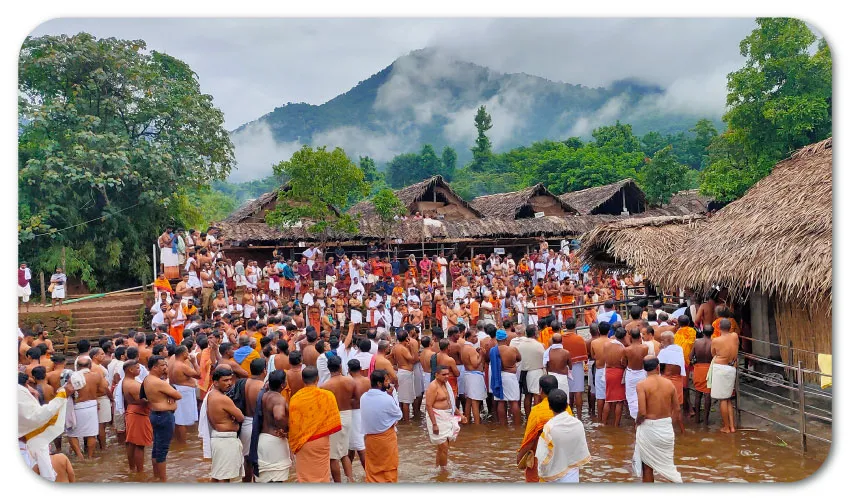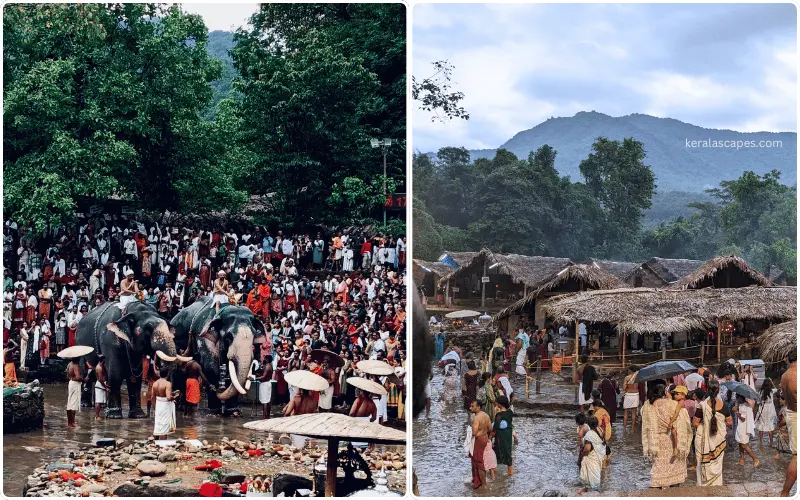Kottiyoor Mahadeva Temple
The Kottiyoor Temple, situated in the northern part of Kerala state in southern India, is recognized as one of the oldest Hindu pilgrimage sites on Earth. Nestled amidst the picturesque Sahya mountain range valley, this temple boasts breathtaking natural beauty. The temple complex consists of two distinct shrines, Akkare Kottiyur and Ikkare Kottiyur, located on opposite banks of the Bavali river. It is worth noting that Akkare Kottiyur temple is accessible exclusively during the Kottiyoor Vaisakha Maholsavam festival.

Kottiyoor Temple Important Details
In Kottiyoor, there are two temples located on opposite banks of the Vavali river. The shrine on the eastern bank, also known as Kizhakkeshwaram or Akkare Kottiyoor, is a temporary hermitage (Yaga shrine) that is only open during the Kottiyoor Vysakha Mahotsavam festival. On the other hand, the Vadakkeshwaram or Ikkare Kottiyoor (The Thruchherumana Temple) on the western bank of the river is a permanent temple complex, similar to other temples. It remains closed throughout the year, except for the 27 days of the Vysakha festival.
The temple is situated in a densely forested area, surrounded by a sacred grove spanning approximately 80 acres. According to mythology, Akkare Kottiyoor, the shrine on the eastern bank of the river, was the site of the Daksha Yaga, where Sati Devi immolated herself at its conclusion.
Legend of Kottiyoor Temple
The Kottiyoor temple, also referred to as “Dekshina Kaasi,” holds a significant place on the Sahyaadri mountains as the sacred site of the “Daksha yaaga.” Daksha, the son of Brahma Deva and a Prajapathi, organized an elaborate yaaga but intentionally excluded his daughter Sathi and son-in-law Lord Siva from the event. Despite Lord Siva’s warning, Sathi defied her father’s wishes and attended the yaaga, only to be subjected to immense insult and humiliation by Daksha. Overwhelmed by shame, Sathi immolated herself in the yaaga fire.
In his fury, Lord Siva manifested two deities named Veerabadra and Badrakali, who unleashed chaos upon the yaaga, ultimately leading to the demise of Daksha. Witnessing the catastrophic events, Lord Brahma and Lord Vishnu approached Lord Siva, beseeching him to quell his anger. Moved by their pleas, Siva agreed to restore Daksha’s life to ensure the completion of the yaaga, replacing his missing head with that of a lamb.
Kottiyur Shiva Temple is also known as Dakshina Kashi or Kashi of South India.
Centuries later, in the midst of a dense forest, an astonishing discovery was made. A bleeding stone was found, believed to be the exact spot where the Daksha yaaga transpired. This remarkable bleeding stone is considered a “swayambu idol,” believed to have been naturally formed by Lord Siva himself near the site where Sathi immolated herself. This sacred area came to be known as “Akkare Kottiyoor.” It is opened to the public exclusively during the Vyskha Mahotsavam festival. In contrast, “Ikkare Kottiyoor” is a temple complex where regular poojas and rituals are conducted in accordance with the spiritual vision of Sri Shankaracharya.
Kottiyoor Vaisakha Maholsavam
Kottiyoor Ulsavam, also known as Kottiyoor Vysakha Mahotsavam, is an annual 27-day pilgrimage celebrated by Hindus, which holds significance in the mythology of Daksha Yaga. This pilgrimage bears resemblance to the Kumbh Mela of Prayag, where devotees partake in ritualistic ablutions. The temple and its surroundings are commonly referred to as Dakshina Kasi.

The Kottiyoor festival takes place from the Swati Nakshatra of the Saka calendar month of Vaisakha to the Chitra Nakshatra of Jyaistha month. In the Malayalam calendar, this corresponds to the months of Medam-Edavam to Edavam-Mithunam, or in the Gregorian calendar, May-June to June-July. The pilgrimage occurs during the monsoon season, characterized by abundant rainfall in the region. The flow of the Vavali river is ideal for ablutions, and the sacred pond Tiruvanchira is filled with water. The climate during the pilgrimage is generally moderate to slightly cold.
While the pilgrimage is known as Kottiyoor Ulsavam or Kottiyoor Festival, the focus is primarily on religious rituals, with no entertainment programs similar to festivals held in other temples. The activities revolve solely around reciting Vedic hymns and performing priestly rites and rituals.
Location and Contact Details of Kottiyoor Shiva Temple
Address:
Sree Thricherumanna Alias Kottiyoor Devaswom
P.O. Kottiyoor, Kannur Dist, Pin-670 651
Telephone: +91 490 2430234 , 2430434
Email: kottiyoordevaswom@gmail.com
Website: www.kottiyoordevaswom.com
Read More about the most famous temples in Kerala: Top 25 Kerala Temples
